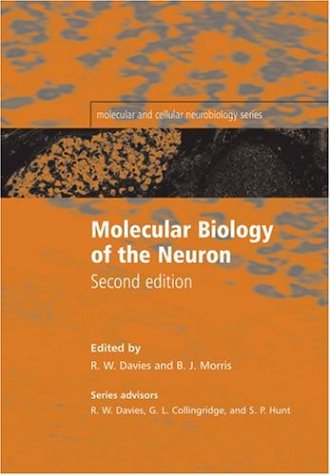B. J. Morris, R. W. Davies9780198509981, 0-19-850998-7
Table of contents :
Cover Page……Page 1
Title Page……Page 4
ISBN 0198509987……Page 5
Preface……Page 6
Contents……Page 8
Contributors……Page 10
Abbreviations……Page 14
Introduction……Page 20
Behaviour……Page 21
Neurogenetics……Page 22
Neurophysiology……Page 26
Neuroinformatics and high-throughput technologies……Page 27
Conclusions……Page 30
Why the mouse?……Page 34
Methods useful for mouse neurogenetics……Page 35
Selected neurological mouse mutants……Page 40
Hereditary neurodegenerative diseases: natural and transgenic models……Page 43
Genetic control of behaviour, cognitive functions and memory formation……Page 44
Outlook……Page 45
Introduction……Page 48
Promoter analysis for the study of neuron-specific regulatory elements……Page 50
Regulation of neuronal gene expression by the neuron-restrictive silencer……Page 53
The regulation of neuronal gene expression by population-specific transcription factors……Page 57
Developmental acquisition of a neuronal phenotype — population-specific transcription factor cascades……Page 61
Organizing neuronal function at the transcriptional level — synexpression groups……Page 66
Specifying neuronal functions at the transcriptional level — the choice amongst the many……Page 70
Regulation of gene expression by growth factors — a path from development to plasticity……Page 73
Ca2+-dependent regulation of neural gene expression……Page 74
Transcriptional regulation of learning processes……Page 76
Perspective……Page 78
Acknowledgements……Page 80
Introduction……Page 94
Regulated transport to the trans-Golgi network……Page 96
Morphology……Page 98
Development of polarity……Page 100
Polarity in mature neurons……Page 101
Polarity signals……Page 105
Postsynaptic targeting……Page 107
Postsynaptic removal of receptors……Page 113
B D E……Page 114
Future prospects……Page 117
Introduction……Page 122
The voltage sensor of ion channels……Page 124
Voltage-gated sodium channels……Page 126
Voltage-gated potassium channels……Page 128
Inwardly rectifying potassium channels and cell excitability……Page 137
Voltage-gated calcium channels……Page 139
Channelopathies……Page 143
Acknowledgments……Page 146
Introduction……Page 158
Modern concepts in neurotransmitter release……Page 160
Learning and synapses……Page 172
Concluding remarks……Page 176
Structural features and components of the excitatory PSD……Page 184
Functional interactions between PSD components……Page 192
The PSD in synaptic plasticity……Page 193
PSD structure and pathophysiology of the CNS……Page 194
Conclusions……Page 196
Abbreviations……Page 200
Introduction……Page 202
The receptor molecules……Page 206
Molecular diversity and its control……Page 207
Receptor assembly and trafficking……Page 217
3D Structure and the molecular basis of receptor properties……Page 220
Outlook……Page 224
Introduction……Page 234
Overall structural features……Page 239
Receptor–Ligand interactions……Page 243
Receptor-G protein interactions……Page 245
Regulation of G protein-coupled receptor function……Page 253
Conclusions……Page 259
Introduction……Page 268
Synaptic plasticity in the nervous system……Page 269
The physiological importance of CREB……Page 272
The mechanism of CREB activation……Page 273
Decoding the calcium signal……Page 277
Concluding remarks……Page 281
Introduction……Page 290
Receptor tyrosine kinases……Page 291
Mechanisms of activation and signalling of receptor tyrosine kinases……Page 293
Non-receptor tyrosine kinases……Page 296
Tyrosine phosphatases……Page 300
Role of protein tyrosine phosphorylation during development of the nervous system……Page 301
Role of tyrosine phosphorylation in the regulation of ion channels and receptors……Page 302
Role of protein tyrosine phosphorylation in synaptic plasticity……Page 303
Conclusion……Page 305
Introduction……Page 310
Ser/Thr protein kinases……Page 311
Neuronal substrates of kinases……Page 321
12.4 Role of the kinases in synaptic transmission and cross-talk between the different kinase pathways……Page 324
Role of the kinases in synaptic plasticity……Page 325
Serine threonine phosphatases……Page 328
Acknowledgments……Page 330
Introduction……Page 336
Components of the neuronal cytoskeleton……Page 337
The cytoskeleton in neuronal morphogenesis……Page 350
The cytoskeleton in neuronal plasticity……Page 358
The cytoskeleton in intraneuronal transport……Page 359
The cytoskeleton in neurodegenerative diseases……Page 365
Experimental models of neuronal plasticity……Page 376
Temporal phases of synaptic plasticity……Page 379
Ca2+ as the trigger……Page 380
Rapid, transient plasticity……Page 381
Slower, sustained plasticity……Page 385
Unanswered questions……Page 396
Introduction……Page 406
Disorders of neural induction, neurogenesis, and neuronal migration……Page 409
Disorders of neuronal terminal differentiation and maturation, and of mature neuronal function……Page 416
Disorders of apoptotic neuronal cell death and neurodegeneration……Page 432
Acknowledgements……Page 448
Introduction……Page 458
Concepts in ageing research……Page 459
Damage, repair and disposal……Page 461
Ageing and the MTR trinity……Page 464
Comparative biology of ageing……Page 469
How does telomere biology link to apoptosis and necrosis?……Page 470
How might stasis contribute to pathogenesis?……Page 473
Neuronal stem cells……Page 475
Major genetic triggers of neuronal death……Page 476
Conclusion……Page 479
A……Page 488
B,C……Page 489
E……Page 490
F,G……Page 491
I……Page 492
M……Page 493
N……Page 494
Q,R……Page 496
S……Page 497
U……Page 498
V,W,X,Y,Z……Page 499







Reviews
There are no reviews yet.